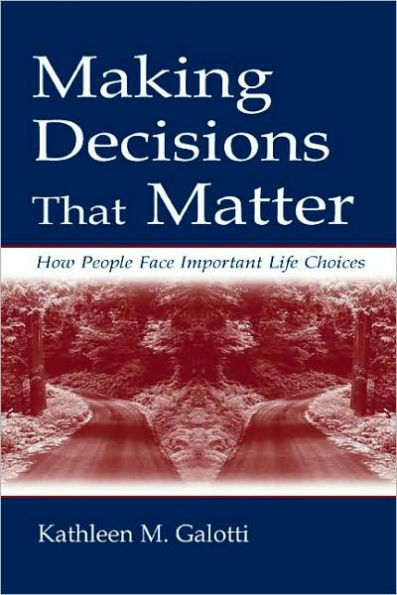Making Decisions That Matter: How People Face Important Life Choices / Edition 1
Researchers studying decision making have traditionally studied the phenomenon in the laboratory, with hypothetical decisions that may or may not involve the decision maker's values, passions, or areas of expertise. The assumption is that the findings of these well-controlled laboratory studies will shed light on the important decisions people make in their everyday lives. This book examines that assumption.
The volume begins by covering four basic phases of decision making: setting or clarifying goals, gathering information, structuring the decision, and making a final choice. Comprehensive reviews of existing literature on each of these topics is provided. Next, the author examines differences in decision making as a function of several factors not typically discussed in the literature: the type of decision being made (e.g., legal, medical, moral) and the existence of individual differences in the decision maker (developmental differences, individual differences in style or temperament, differences as a function of expertise). The author then examines the topic of group decision making, contrasting it with individual decision making. The volume concludes with some observations and suggestions for improving peoples' everyday decision making.
This book is intended for use as a core textbook or supplement for courses in psychology, education, or allied disciplines. It will also be an invaluable resource for people who work with people making decisions in various applied settings, such as schools, universities, and health care centers.
1103843765
The volume begins by covering four basic phases of decision making: setting or clarifying goals, gathering information, structuring the decision, and making a final choice. Comprehensive reviews of existing literature on each of these topics is provided. Next, the author examines differences in decision making as a function of several factors not typically discussed in the literature: the type of decision being made (e.g., legal, medical, moral) and the existence of individual differences in the decision maker (developmental differences, individual differences in style or temperament, differences as a function of expertise). The author then examines the topic of group decision making, contrasting it with individual decision making. The volume concludes with some observations and suggestions for improving peoples' everyday decision making.
This book is intended for use as a core textbook or supplement for courses in psychology, education, or allied disciplines. It will also be an invaluable resource for people who work with people making decisions in various applied settings, such as schools, universities, and health care centers.
Making Decisions That Matter: How People Face Important Life Choices / Edition 1
Researchers studying decision making have traditionally studied the phenomenon in the laboratory, with hypothetical decisions that may or may not involve the decision maker's values, passions, or areas of expertise. The assumption is that the findings of these well-controlled laboratory studies will shed light on the important decisions people make in their everyday lives. This book examines that assumption.
The volume begins by covering four basic phases of decision making: setting or clarifying goals, gathering information, structuring the decision, and making a final choice. Comprehensive reviews of existing literature on each of these topics is provided. Next, the author examines differences in decision making as a function of several factors not typically discussed in the literature: the type of decision being made (e.g., legal, medical, moral) and the existence of individual differences in the decision maker (developmental differences, individual differences in style or temperament, differences as a function of expertise). The author then examines the topic of group decision making, contrasting it with individual decision making. The volume concludes with some observations and suggestions for improving peoples' everyday decision making.
This book is intended for use as a core textbook or supplement for courses in psychology, education, or allied disciplines. It will also be an invaluable resource for people who work with people making decisions in various applied settings, such as schools, universities, and health care centers.
The volume begins by covering four basic phases of decision making: setting or clarifying goals, gathering information, structuring the decision, and making a final choice. Comprehensive reviews of existing literature on each of these topics is provided. Next, the author examines differences in decision making as a function of several factors not typically discussed in the literature: the type of decision being made (e.g., legal, medical, moral) and the existence of individual differences in the decision maker (developmental differences, individual differences in style or temperament, differences as a function of expertise). The author then examines the topic of group decision making, contrasting it with individual decision making. The volume concludes with some observations and suggestions for improving peoples' everyday decision making.
This book is intended for use as a core textbook or supplement for courses in psychology, education, or allied disciplines. It will also be an invaluable resource for people who work with people making decisions in various applied settings, such as schools, universities, and health care centers.
51.99
In Stock
5
1

Making Decisions That Matter: How People Face Important Life Choices / Edition 1
190
Making Decisions That Matter: How People Face Important Life Choices / Edition 1
190Paperback(New Edition)
$51.99
51.99
In Stock

Product Details
| ISBN-13: | 9780805833973 |
|---|---|
| Publisher: | Taylor & Francis |
| Publication date: | 05/01/2002 |
| Edition description: | New Edition |
| Pages: | 190 |
| Product dimensions: | 6.00(w) x 9.00(h) x (d) |
From the B&N Reads Blog
